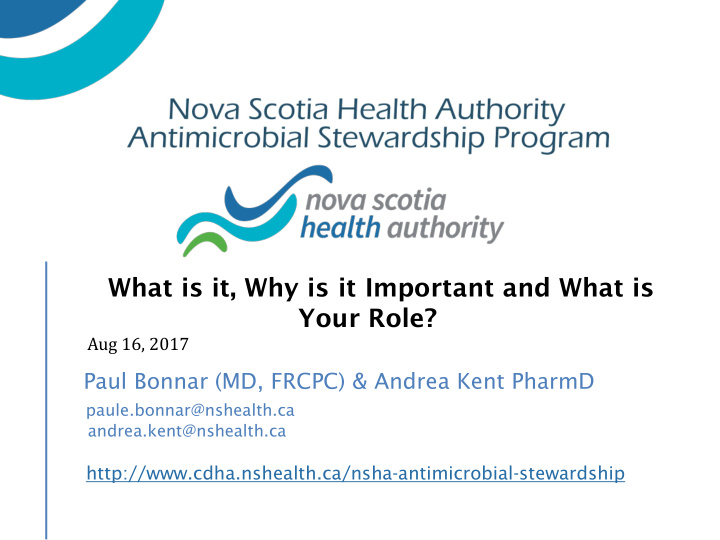



What is it, Why is it Important and What is Your Role? Aug 16, 2017 Paul Bonnar (MD, FRCPC) & Andrea Kent PharmD paule.bonnar@nshealth.ca andrea.kent@nshealth.ca http://www.cdha.nshealth.ca/nsha-antimicrobial-stewardship
What is Antimicrobial Stewardship? • Coordinated interventions designed to improve and measure the appropriate use of antibiotics Right drug Right dose Right duration Right route Barlam. CID. 2016;62(10):e51 – e77 Tamma CID 2017 ;64(5):537 – 43
WHY IS AMS IMPORTANT?
What Does a ‘Post Antibiotic Era’ mean?
It means we are heading back to a time where common illnesses like pneumonia and minor surgical procedures will once again be feared killers because we do not have antibiotics to combat them due to developing resistance. Fluoroquinolones which were introduced in 1980 with zero resistance now have as much as 50% resistance to E. coli in some countries MRSA counts for almost 90% of Staph infections in parts of the USA People with MRSA infections have a 64% increase risk of death
Why is AMS Important? O’Neill. 2014. Antimicrobial Resistance: Tackling a crisis for the health and wealth of nations
Why is AMS Important? • Increasing MDR organisms • Side-effects / costs of antimicrobials • Accreditation Canada ROP O’Neill. Antimicrobial Resistance: Tackling a crisis for the health and wealth of nations
Tamma. JAMA Intern Med. 2017 Jun 12
VISION • Safe and effective use of antimicrobial agents in patients cared for in the NSHA
TENETS Promote a culture of optimal antibiotic use • Respect and promote regional strengths • Act in collaborative and engaging manner • Make evidence-based recommendations • Maintain an open/transparent program • Start small, build on success •
Andrea Kent Team members Paul Bonnar Ian Davis Kim Abbass Jason Reynolds Valerie Murphy Stephen Smith
WHAT IS NURSING’S ROLE?
CID 2016;62(1):84 – 9
CID 2016;62(1):84 – 9
Situation • 30 – 40% of patients will receive an antibiotic while in hospital • Growing number of resistant bacteria • Most nursing staff will come face to face with the consequences of our antimicrobial resistance crisis
Survey of nursing staff in Australia • 65% knew or had heard of the term Antimicrobial Stewardship or AMS • 57% rated their knowledge of antimicrobials as minimal or limited • Hand hygiene, infection control, and knowledge of antimicrobials were most commonly seen as nursing role • Prompting switch from IV to oral, therapeutic drug monitoring and checking restriction status were less frequently thought of as nursing roles Infection, Disease & Health (2017) 22, 57e64
Why has nursing not been a focus? • Prescribing emphasized over MANAGING antibiotics • Hierarchy & Tradition • Time constraints • Knowledge
What is Nursing’s Role in AMS? • AMS is multidisciplinary • Nurses are the operational and communication hub • Trusted by patients and families • Many existing roles of nursing already fit well with AMS roles
Nursing benefits • Better patient outcomes • Less resistance: less isolation • Less C. difficile • Less abx administration
CID 2016;62(1):84 – 9
CID 2016;62(1):84 – 9
Triage - Early recognition of sepsis Early cultures and Abx Clarification of allergies Daily nursing care - Monitor abx (duration, dose, IV) -Early C diff / sepsis - Correct culturing - Culture reports -Educating families - Prevention (catheter removal) Discharge - Duration -OPAT - Follow-ups
Allergies • Penicillin most commonly reported allergy • 95% are not truly allergic reactions • Minor adverse reactions or intolerances (eg nausea or diarrhea) • Non severe delayed type hypersensitivity reactions (eg. maculopapular rashes)
Allergies • Over reporting of allergies is NOT benign • Alternative antibiotics may be less effective or have more adverse effects • Increased selection of resistant bacteria • More often on more than one antibiotic • Increased risk of ICU admission • Longer lengths of stay • Increased risk of death
What can Nursing Do? • Ask what the reaction was • If on old charts – question further
Catheters and CAUTI • In one centre a nurse directed catheter removal protocol reduced catheter use by 50% and CAUTI by 70%. • ICU nurse reminders to physicians for catheter removal reduced both CAUTI and costs
https://www.ammi.ca/?ID=127
https://choosingwiselycanada.org/nursing/
Managing the Patient with a possible UTI: Facts !! Malodorous /cloudy urine alone is NOT a sign /symptom of a UTI Changes in cognitive function or ADL’s require a clinical assessment first before assuming this is due to a UTI Urine should always be collected as a midstream or in/out catheterization
Managing the Patient with a possible UTI: Facts!! Positive urine cultures in asymptomatic patients should NOT be automatically treated (except in pregnancy or prior to urological/gynecological procedures UTI is a clinical diagnosis…not a lab diagnosis!! Delirium is not considered a typical symptom of a UTI for non-catheterized patients.
Questions?
Recommend
More recommend